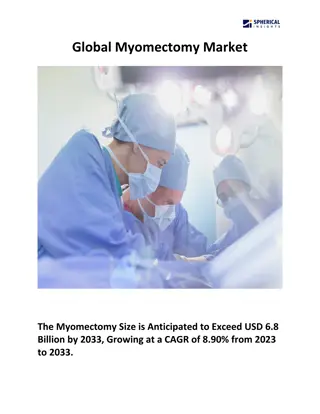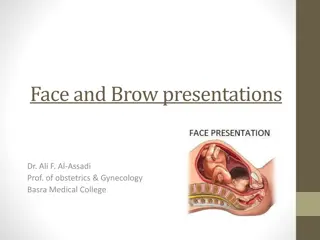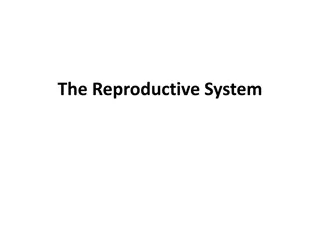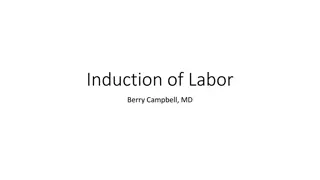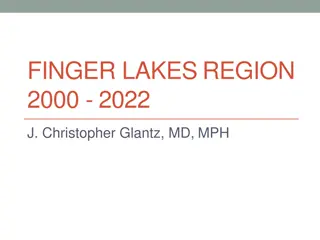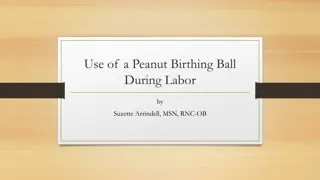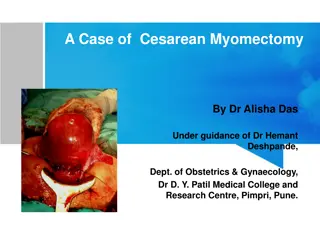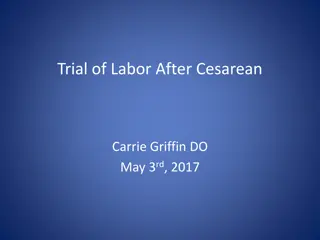Placenta Accreta Syndrome: Definition, Risk Factors, Diagnosis, and Management
Placenta Accreta Syndrome (PAS) is characterized by abnormal placental implantation with firm adherence to the uterine muscle due to the absence of certain layers. Risk factors include previous cesarean section, placenta previa, advanced maternal age, and uterine anomalies. Diagnosis involves ultras
0 views • 16 slides
Maternal and Fetal Complications of Obesity in Pregnancy
Understanding the impact of obesity stigma as a stressor throughout the lifecourse is essential, especially concerning pregnancy. The prevalence of pre-pregnancy overweight and obesity poses significant risks, leading to various maternal complications like gestational diabetes, cesarean delivery, an
0 views • 62 slides
Global Myomectomy Market
The Myomectomy Size is Anticipated to Exceed USD 6.8 Billion by 2033, Growing at a CAGR of 8.90% from 2023 to 2033.\n
1 views • 5 slides
Understanding Cesarean Section and Preterm Labor Risks
Cesarean section (C/S) is a delivery method for various fetal and maternal indications, while preterm labor poses risks like twin pregnancy, uterine abnormalities, and infections. Complications of C-sections and signs of preterm labor are discussed, highlighting the importance of early recognition a
0 views • 9 slides
Understanding Face and Brow Presentations in Obstetrics & Gynecology
Face and brow presentations are rare occurrences in labor, with causes varying from fetal positioning to maternal factors. Diagnosis involves abdominal and vaginal examinations, with management strategies including cesarean section in certain cases. Understanding the mechanisms and diagnosis of thes
0 views • 12 slides
Understanding the Reproductive System: Terms, Disorders, and Procedures
Exploring the terminology, physiology, and common disorders related to the reproductive system, including definitions of key terms like amniotic sac, androgens, diploid cell, gamete, ovulation, and more. Learn about reproductive system disorders such as ectopic pregnancy, endometriosis, and menopaus
0 views • 9 slides
Cesarean Delivery Timing Guidelines for Women with Prior Uterine Scars
Society for Maternal Fetal Medicine provides cesarean delivery timing recommendations for women with prior uterine scars. For those with a history of classical cesarean, the risk of uterine rupture guides the timing of repeat cesarean. Similarly, women with prior myomectomy should plan delivery betw
0 views • 10 slides
Induction of Labor: Methods and Considerations
Induction of labor is done to achieve vaginal delivery before spontaneous onset, usually at 39 weeks or when medically necessary. Risks include failed induction, cesarean section, uterine rupture, prolonged labor, and infections. Cervical ripening methods help prepare the cervix for labor. The Bisho
0 views • 18 slides
Maternity Trends in Finger Lakes Region 2000-2022
Maternity trends in the Finger Lakes region from 2000 to 2022 show a decline in hospital delivery volumes, with a decrease in the number of hospitals providing maternity services. Changes in delivery practices include increases in Medicaid coverage, epidural usage, and breastfeeding rates, while the
0 views • 13 slides
Effectiveness of Peanut Birthing Ball in Laboring Mothers with Epidural
The use of a peanut birthing ball during labor for mothers with epidurals aims to reduce the duration of the first stage of labor and decrease the incidence of primary cesarean sections. Evidence suggests that peanut balls help open the maternal pelvis, aiding in fetal rotation and descent. This int
0 views • 10 slides
Case Study: Cesarean Myomectomy Conducted by Dr. Alisha Das
A 25-year-old female primigravida underwent a cesarean myomectomy procedure at Dr. D. Y. Patil Medical College and Research Centre. The patient had a normal pregnancy history with no significant medical issues. Detailed history, examination findings, and abdominal assessment were reported in prepara
0 views • 25 slides
Understanding Third Trimester Bleeding: Causes, Evaluation, and Management
Third trimester bleeding can be caused by various factors like placental abruption and previa, requiring prompt evaluation including assessing fetal heart rate and determining placental location. Different complications can arise for both the mother and fetus, necessitating specific management plans
0 views • 17 slides
Understanding Trial of Labor After Cesarean (TOLAC) for VBAC Success
Explore the historical evolution of Vaginal Birth After Cesarean (VBAC) and Trial of Labor After Cesarean (TOLAC), including counseling patients on risks and success rates, labor management, complications, and strategies to prevent the need for a TOL. Delve into key milestones from ACOG encouraging
0 views • 46 slides
Understanding the Trends and Factors Behind Labor Inductions and Cesarean Births
Analyzing the data presented, the content explores the prevalence of labor inductions, reasons for medical interventions during childbirth, and factors contributing to primary and repeat cesarean births. It delves into statistics from the US between 1990-2013, shedding light on the increasing rates
0 views • 11 slides


